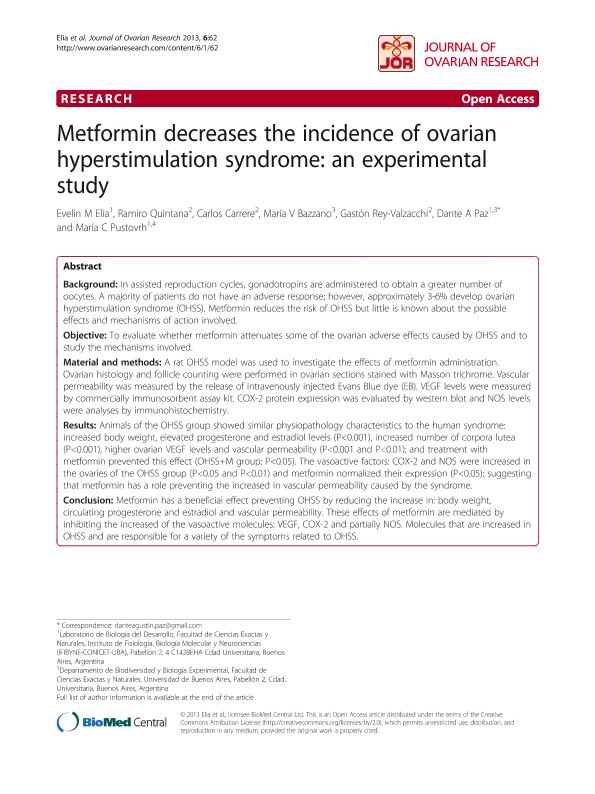Mostrar el registro sencillo del ítem
dc.contributor.author
Elia, Evelin Mariel

dc.contributor.author
Quintana, Ramiro

dc.contributor.author
Carrere, Carlos
dc.contributor.author
Bazzano, María Victoria

dc.contributor.author
Rey Valzacchi, Gastón
dc.contributor.author
Paz, Dante Agustin

dc.contributor.author
Pustovrh, María Carolina

dc.date.available
2017-07-21T18:17:39Z
dc.date.issued
2013-09
dc.identifier.citation
Elia, Evelin Mariel; Quintana, Ramiro; Carrere, Carlos; Bazzano, María Victoria; Rey Valzacchi, Gastón; et al.; Metformin decreases the incidence of ovarian hyperstimulation syndrome: an experimental study; BioMed Central; Journal of Ovarian Research; 6; 1; 9-2013; 62-70; 62
dc.identifier.issn
1757-2215
dc.identifier.uri
http://hdl.handle.net/11336/21097
dc.description.abstract
Background: In assisted reproduction cycles, gonadotropins are administered to obtain a greater number of oocytes. A majority of patients do not have an adverse response; however, approximately 3-6% develop ovarian hyperstimulation syndrome (OHSS). Metformin reduces the risk of OHSS but little is known about the possible effects and mechanisms of action involved. Objective: To evaluate whether metformin attenuates some of the ovarian adverse effects caused by OHSS and to study the mechanisms involved. Material and methods: A rat OHSS model was used to investigate the effects of metformin administration. Ovarian histology and follicle counting were performed in ovarian sections stained with Masson trichrome. Vascular permeability was measured by the release of intravenously injected Evans Blue dye (EB). VEGF levels were measured by commercially immunosorbent assay kit. COX-2 protein expression was evaluated by western blot and NOS levels were analyses by immunohistochemistry. Results: Animals of the OHSS group showed similar physiopathology characteristics to the human syndrome: increased body weight, elevated progesterone and estradiol levels (P<0.001), increased number of corpora lutea (P<0.001), higher ovarian VEGF levels and vascular permeability (P<0.001 and P<0.01); and treatment with metformin prevented this effect (OHSS+M group; P<0.05). The vasoactive factors: COX-2 and NOS were increased in the ovaries of the OHSS group (P<0.05 and P<0.01) and metformin normalized their expression (P<0.05); suggesting that metformin has a role preventing the increased in vascular permeability caused by the syndrome. Conclusion: Metformin has a beneficial effect preventing OHSS by reducing the increase in: body weight, circulating progesterone and estradiol and vascular permeability. These effects of metformin are mediated by inhibiting the increased of the vasoactive molecules: VEGF, COX-2 and partially NOS. Molecules that are increased in OHSS and are responsible for a variety of the symptoms related to OHSS.
dc.format
application/pdf
dc.language.iso
eng
dc.publisher
BioMed Central

dc.rights
info:eu-repo/semantics/openAccess
dc.rights.uri
https://creativecommons.org/licenses/by-nc-sa/2.5/ar/
dc.subject
Síndrome de Hiperestimulación Ovarica
dc.subject
Metformina
dc.subject
Vegf
dc.subject
Permeabilidad Vascular
dc.subject.classification
Patología

dc.subject.classification
Medicina Básica

dc.subject.classification
CIENCIAS MÉDICAS Y DE LA SALUD

dc.title
Metformin decreases the incidence of ovarian hyperstimulation syndrome: an experimental study
dc.type
info:eu-repo/semantics/article
dc.type
info:ar-repo/semantics/artículo
dc.type
info:eu-repo/semantics/publishedVersion
dc.date.updated
2017-07-18T15:34:18Z
dc.journal.volume
6
dc.journal.number
1
dc.journal.pagination
62-70; 62
dc.journal.pais
Reino Unido

dc.journal.ciudad
Londres
dc.description.fil
Fil: Elia, Evelin Mariel. Consejo Nacional de Investigaciones Científicas y Técnicas. Oficina de Coordinación Administrativa Ciudad Universitaria. Instituto de Fisiología, Biología Molecular y Neurociencias. Universidad de Buenos Aires. Facultad de Ciencias Exactas y Naturales. Instituto de Fisiología, Biología Molecular y Neurociencias; Argentina
dc.description.fil
Fil: Quintana, Ramiro. Procrearte Medicina Reproductiva y Molecular; Argentina
dc.description.fil
Fil: Carrere, Carlos. Procrearte Medicina Reproductiva y Molecular; Argentina
dc.description.fil
Fil: Bazzano, María Victoria. Universidad de Buenos Aires. Facultad de Ciencias Exactas y Naturales. Departamento de Biodiversidad y Biología Experimental; Argentina. Consejo Nacional de Investigaciones Científicas y Técnicas; Argentina
dc.description.fil
Fil: Rey Valzacchi, Gastón. Procrearte Medicina Reproductiva y Molecular; Argentina
dc.description.fil
Fil: Paz, Dante Agustin. Consejo Nacional de Investigaciones Científicas y Técnicas. Oficina de Coordinación Administrativa Ciudad Universitaria. Instituto de Fisiología, Biología Molecular y Neurociencias. Universidad de Buenos Aires. Facultad de Ciencias Exactas y Naturales. Instituto de Fisiología, Biología Molecular y Neurociencias; Argentina
dc.description.fil
Fil: Pustovrh, María Carolina. Consejo Nacional de Investigaciones Científicas y Técnicas. Oficina de Coordinación Administrativa Ciudad Universitaria. Instituto de Fisiología, Biología Molecular y Neurociencias. Universidad de Buenos Aires. Facultad de Ciencias Exactas y Naturales. Instituto de Fisiología, Biología Molecular y Neurociencias; Argentina. Universidad del Valle; Colombia
dc.journal.title
Journal of Ovarian Research
dc.relation.alternativeid
info:eu-repo/semantics/altIdentifier/doi/http://dx.doi.org/10.1186/1757-2215-6-62
dc.relation.alternativeid
info:eu-repo/semantics/altIdentifier/url/https://ovarianresearch.biomedcentral.com/articles/10.1186/1757-2215-6-62
Archivos asociados
